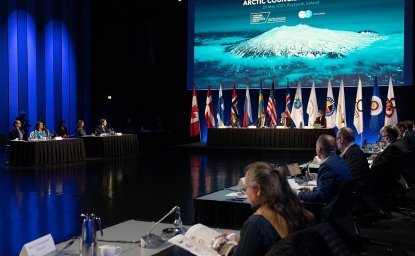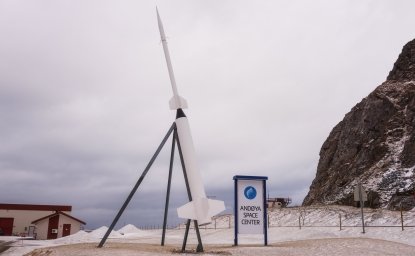U.S., Russia Must Keep Talking, Cooperating in Arctic
Despite conflicts elsewhere and increased brinkmanship, the United States and Russia must keep talking and working together in the increasingly open Arctic.
Despite conflicts elsewhere and increased brinkmanship, the United States and Russia must keep talking and working together in the increasingly open Arctic.
September 25, 2015
The Obama administration is changing its tone toward Russia by opening a dialogue with Moscow regarding air operations in Syria’s war zone. President Barack Obama instructed his defense secretary to coordinate military actions with his Russian counterpart, and will meet with Russia President Vladimir Putin next week on the margins of the United Nations to gain policy clarity on Syria and Ukraine. At the same time the White House is considering increasing sanctions on Russia for its violation of Ukraine’s sovereignty. While the president is ready to engage Russia regarding Syria, U.S. policymakers must find common ground with Russia in the Arctic region. Despite the frayed relations over Ukraine, it is essential there be no policy spillover into the Arctic.
Provocative and more assertive military activities have accelerated in the past several years. Russia is upgrading, modernizing, deploying and testing its military assets, including those in the Arctic. As America celebrated Independence Day, two long-range Russian Bear-H bombers delivered a Fourth of July greeting just outside of U.S. airspace within 63 miles of the coast of Alaska. Air Force F-22 fighter jets scrambled to intercept the Russian planes. On the same day the bombers probed America’s West Coast, Putin called Obama to wish him a happy Independence Day.
Dangerous brinkmanship
NATO fighter jets have stepped up exercises near the Russian border, and scrambled more than 250 times throughout Europe to intercept Russian aircraft, generally in international airspace. Some 120 encounters over the Baltic nations have occurred so far this year. This number is expected to surpass those of the past two years, although far fewer than during the Cold War. Russia’s muscle flexing, close over-flights, mock bombing missions, reconnaissance and air exercises, appears to be largely focused on NATO nations, or allies, which have conducted their own military exercises and overflights near the Russian border. The increased activity is causing unease amongst citizens and governments alike.
The aerial ballet of dueling military exercises has led alarmed policymakers to call this military jousting, “dangerous brinksmanship.” NATO and Russian fighter jets “shadow” each other’s reconnaissance flights and observe live fire exercises, with both parties engaging in episodic buzzing in and out of international airspace.
Russia’s creation of a Joint Strategic Command, based in its Northern Fleet, is identified by some as evidence of the Kremlin’s questionable military intentions. At the same time, the U.S. Navy strategic objectives for the Arctic, as expressed in the U.S. Navy Arctic Roadmap 2014-2030, calls for both backup for the Coast Guard, and identifies as priorities the maintenance of open seas, which includes through transit of coastal shipping routes in Russian and Canadian Arctic seas.
Meeting 21st Century challenges: Military to military communication
Within this context of increased military activity, the European Leadership Network’s Task Force on Cooperation in Greater Europe, devoted to “breaking the legacy of the Cold War,” urged NATO and Russia to engage in direct dialogue in order to minimize military risk. The task force recommends reconvening the NATO-Russia Council and expanding the 2002 Treaty on Open Skies as a basis for a rules-based Arctic security architecture. At the same time, Washington has reportedly requested meetings under the 1972 U.S.-Soviet Agreement on Preventing Dangerous Accidents in the Air. These recommendations are collectively a good step in the right direction.
Events on the ground, in a heightened security environment, can be misunderstood. Moscow’s approach to the Arctic is to govern, protect and exercise control over plans for infrastructure development, oil and gas production despite a collapse in oil prices, and shipping. The Kremlin plans to build 10 new navigational and emergency centers along its northern coast to strengthen its infrastructure and port facilities. Moscow also plans to augment its existing fleet of 21 icebreakers to escort vessels through its 7,500-mile-long Northern Sea Route.
Arctic security environment more constabulary than military
The security environment in the Arctic is more constabulary than military. The U.S. maritime and infrastructure capabilities there are thin. Retired Adm. Robert J. Papp, the U.S. Special Representative to the Arctic, who has traveled to Russia on several occasions to meet with his counterparts, said he is “envious of Russia’s infrastructure plans” along the NSR. The plans include dual-use installations necessary for search and rescue, spill response and icebreaker capabilities. But, Papp noted of any larger military considerations, “we’re keeping our eye out.”
Two overlapping yet conflicting visions appear to define the Arctic narrative. One maintains that the Arctic is a zone of cooperation, evidenced primarily by the intergovernmental Arctic Council, where all eight Arctic nations cooperate primarily on environmental and scientific challenges.
The other vision, often found in media accounts, sees the Arctic as a setting for state-based, militarized, competition for vast offshore oil and gas reserves with parallel claims to the Outer Continental Shelf, beyond the 200-mile Exclusive Economic Zone. Such accounts often identify opposing claims, governance regarding shipping routes, or exploration for oil and gas reserves, most of which are within existing sovereign zones, as preludes to military conflict, despite evidence to the contrary.
Cooperation vital in the Bering Strait and Sea
Disputes in the Arctic are relatively few, and are typically resolved bilaterally, within the framework of international law. On Sept. 11, Russian and U.S. negotiators signed a bilateral agreement to jointly combat illegal, unreported and unregulated fishing in the Bering Sea. The agreement, signed at the 26th U.S.-Russia Intergovernmental Consultative Committee on Fisheries meeting, is intended to crack down on illegal fishing, and protect the stocks at risk of collapse. The agreement formalizes a working enforcement relationship between the U.S. Coast Guard and the Russian Federal Border Guard.
Russia’s fidelity to international law in the Arctic context is reflected in its resubmission of its United Nations Convention on the Law of the Sea claim for vast undersea territory on its outer continental shelf. As Moscow prepares its NSR for commercial shipping, regional stability is central to Russia’s long-term development plans. Commitment to international law, at least in the Arctic, is likely to continue.
The Kremlin’s 2015 Law of the Sea claim follows the 2010 agreement between the Kingdom of Norway and the Russian Federation that resolves the two nations’ 40-year maritime border dispute. The Norwegian prime minister and Russian president agreed at the signing that their long diplomatic efforts “showed good will” and opened the way for “joint projects” in oil and gas development in the resource rich seabed.
Cooperation is imperative and practical in the rugged and remote Bering Strait that serves as not only as a shipping gateway, but also a potential shipping “chokepoint”—with projected increasing traffic from Russia’s northern coast and Canada’s Northwest Passage. Nautical safety, such as the Coast Guard’s current initiative to develop sea-lanes through the Bering Strait—52 nautical miles wide at its narrowest—must, like the IUU agreement, be developed cooperatively with Russia.
Is current U.S. policy hemming in Russia?
The United States appears to have a three-pronged policy that could contain Russia’s Arctic plans: the current sanctions substantially impact investment, capitalization and development located in the Russian Arctic, particularly the oil and gas sector; the legal characterization of Russia’s coastal waters as “international” rather than “internal” that could generate support from other nations looking northward; and, NATO expansion that Moscow views as an effort to surround its borders. The Kremlin’s belief that the U.S. does not view Russia in equal terms complicates matters, especially in terms of how to achieve cooperation and collaboration in the Arctic.
Arctic regional stability is vital. One of Moscow’s goals is to ensure a stable commercial future in the Arctic region. Although the U.S. is a global maritime power, it has neither the footprint, nor the finances, to shape the Arctic paradigm. Although Washington could place greater emphasis on a leadership role, Russia is, and will likely remain, the indispensable party in the Arctic context for some time.
The Arctic: A joint priority
The Arctic should be treated as a joint priority for the United States, the world’s largest economy, and for the Russian Federation, the largest Arctic nation. While both countries must rethink and reconcile their policies given a rapidly changing Arctic, the U.S. and Russia must make it clear to each other that neither has any intention to encroach on present or future sovereign territory.
Inhibiting cooperation would be a tragedy for both nations, for wider Arctic collaborative processes, and ultimately, for the coastal communities whose lives depend upon the Arctic seas. Both the Russian Federation and the United States must extend the cooperation that is developing in areas as disparate as Syria, the Bering fisheries or a unified Arctic security architecture suggested by the European task force. A deep and mutual understanding in the Arctic by the Russian Federation and the United States could lead to a truly cooperative Arctic, whose strategic thaw just might spill over to the wider, non-Arctic, interests of these great powers.
David N. Biette is director of the Polar Initiative, and senior advisor to the Canada Institute, at the Woodrow Wilson International Center for Scholars. Anita L. Parlow, Esq., is an Oxford educated attorney, and the recent advisor to the Harvard-MIT Arctic Fisheries Project.
The views expressed here are the writers' own and are not necessarily endorsed by Alaska Dispatch News, which welcomes a broad range of viewpoints.
This article was originally published in Alaska Dispatch News on September 25, 2015 (http://www.adn.com/article/20150925/us-russia-must-keep-talking-cooperating-arctic-1)



Since its inception in 2017, the Polar Institute has become a premier forum for discussion and policy analysis of Arctic and Antarctic issues, and is known in Washington, DC and elsewhere as the Arctic Public Square. The Institute holistically studies the central policy issues facing these regions—with an emphasis on Arctic governance, climate change, economic development, scientific research, security, and Indigenous communities—and communicates trusted analysis to policymakers and other stakeholders. Read more



